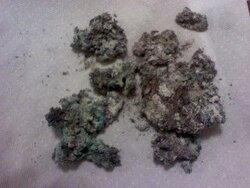I currently have a Vermont DownDrafter that I will be replacing with a Napoleon 1600C.
The initial reason to replace it was that the inside firebrick slab and the heavy sheet metal wall melted/burned away leaving a lot more space to down draft at the bottom. It left a blue chunk of mineral ore looking stuff that smelled like plastic. Well since the new stove doesn't arrive until tomorrow I have continued to use it and found some more of the deposits which if I scrap off the grate and move onto the coals seems like it could burn, but doesn't quite. Also this time there are not parts that seem to be melted in the stove. It is almost coming from nowhere. I have been using a lot of hickory and think that the heat from it and the age of the stove is what burned the firewall initially. But where is the rest of this bluish stuff coming from? Could it possibly be wood creosote, more specifically from hickory? Also I can't even be certain it is hickory, but it is super dense almost like black locust.
The initial reason to replace it was that the inside firebrick slab and the heavy sheet metal wall melted/burned away leaving a lot more space to down draft at the bottom. It left a blue chunk of mineral ore looking stuff that smelled like plastic. Well since the new stove doesn't arrive until tomorrow I have continued to use it and found some more of the deposits which if I scrap off the grate and move onto the coals seems like it could burn, but doesn't quite. Also this time there are not parts that seem to be melted in the stove. It is almost coming from nowhere. I have been using a lot of hickory and think that the heat from it and the age of the stove is what burned the firewall initially. But where is the rest of this bluish stuff coming from? Could it possibly be wood creosote, more specifically from hickory? Also I can't even be certain it is hickory, but it is super dense almost like black locust.


